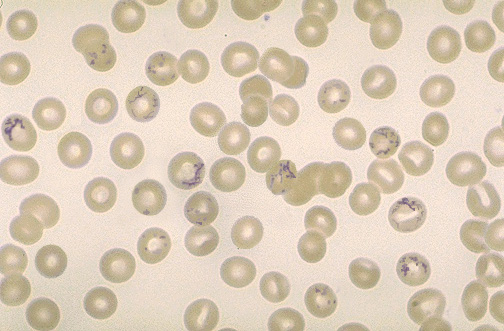



| The supravital stain (methylene blue) applied to this peripheral blood smear reveals the presence of many reticulocytes, which are marked by irregular bluish strands of residual RNA. Reticulocytes are the earliest form of RBC normally present in the peripheral blood. On a peripheral blood smear with Wright-Giemsa stain, such "newly minted" RBCs have a pale bluish appearance, termed polychromasia. A reticulocyte count can help to determine if there is a bone marrow response to anemia. Reticulocytosis is prominent following blood loss in a healthy person and in hemolytic anemias, but blunted or absent when there are nutritional anemias, anemia of chronic disease, myelophthisic processes (infections or neoplasms filling the marrow), aplastic anemia, or marrow damage from radiation or toxins, including drugs. |


 |